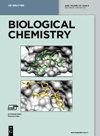从结构角度看 Slo1 钾通道的复杂调控
IF 2.4
4区 生物学
Q3 BIOCHEMISTRY & MOLECULAR BIOLOGY
引用次数: 0
摘要
在包括神经元、肾脏和平滑肌在内的许多动物组织中,通过 Slo1 通道快速调节钾外流至关重要。在过去十年中,有关这些大型复杂分子机器的门控机制和调控的许多细节已被结构所揭示。本综述总结了这些发现以及目前关于这些重要通道复杂调控的知识。Slo1 通过电压传感器结构域感知膜电位,该结构域发生了微妙但重要的结构重排,钙离子诱导细胞内门环部分扩张。这两种信号协同作用,导致孔域的构象和化学性质发生变化,使钾离子得以转运。在许多原生组织中,Slo1 通道至少与三类辅助亚基组装在一起,这些辅助亚基可改变门控动力学,或使通道在没有这两种信号之一的情况下也能打开。最后,天然毒素和合成化合物会抑制、激活或解除对 Slo1 的调控,这凸显了该通道对生物体的重要性,以及作为药物和其他分子潜在靶点的重要性。本文章由计算机程序翻译,如有差异,请以英文原文为准。
The complex regulation of Slo1 potassium channels from a structural perspective
Fast and regulated potassium efflux by Slo1 channels is crucial in many tissues in animals including neurons, the kidney and smooth muscle. During the last decade, structures have revealed many details about the gating mechanism and regulation of these large and complex molecular machines. This review summarizes these findings and the current knowledge about the intricate regulation of these important channels. Slo1 integrates sensing of the membrane potential via a voltage-sensor domain that undergoes subtle but significant structural rearrangements with a calcium-induced expansion of parts of the intracellular gating ring. Together, these two signals synergistically lead to changes in the conformation and chemical nature of the pore domain, allowing potassium ions to be translocated. In many native tissues, Slo1 channels are assembled with at least three classes of auxiliary subunits that change the gating kinetics or allow the channel to open also in absence of one of the two signals. Finally, Slo1 is inhibited, activated or deregulated by natural toxins and synthetic compounds, underlining the importance of the channel for the organism and as a potential target for drugs and other molecules.
求助全文
通过发布文献求助,成功后即可免费获取论文全文。
去求助
来源期刊

Biological Chemistry
生物-生化与分子生物学
CiteScore
7.20
自引率
0.00%
发文量
63
审稿时长
4-8 weeks
期刊介绍:
Biological Chemistry keeps you up-to-date with all new developments in the molecular life sciences. In addition to original research reports, authoritative reviews written by leading researchers in the field keep you informed about the latest advances in the molecular life sciences. Rapid, yet rigorous reviewing ensures fast access to recent research results of exceptional significance in the biological sciences. Papers are published in a "Just Accepted" format within approx.72 hours of acceptance.
 求助内容:
求助内容: 应助结果提醒方式:
应助结果提醒方式:


